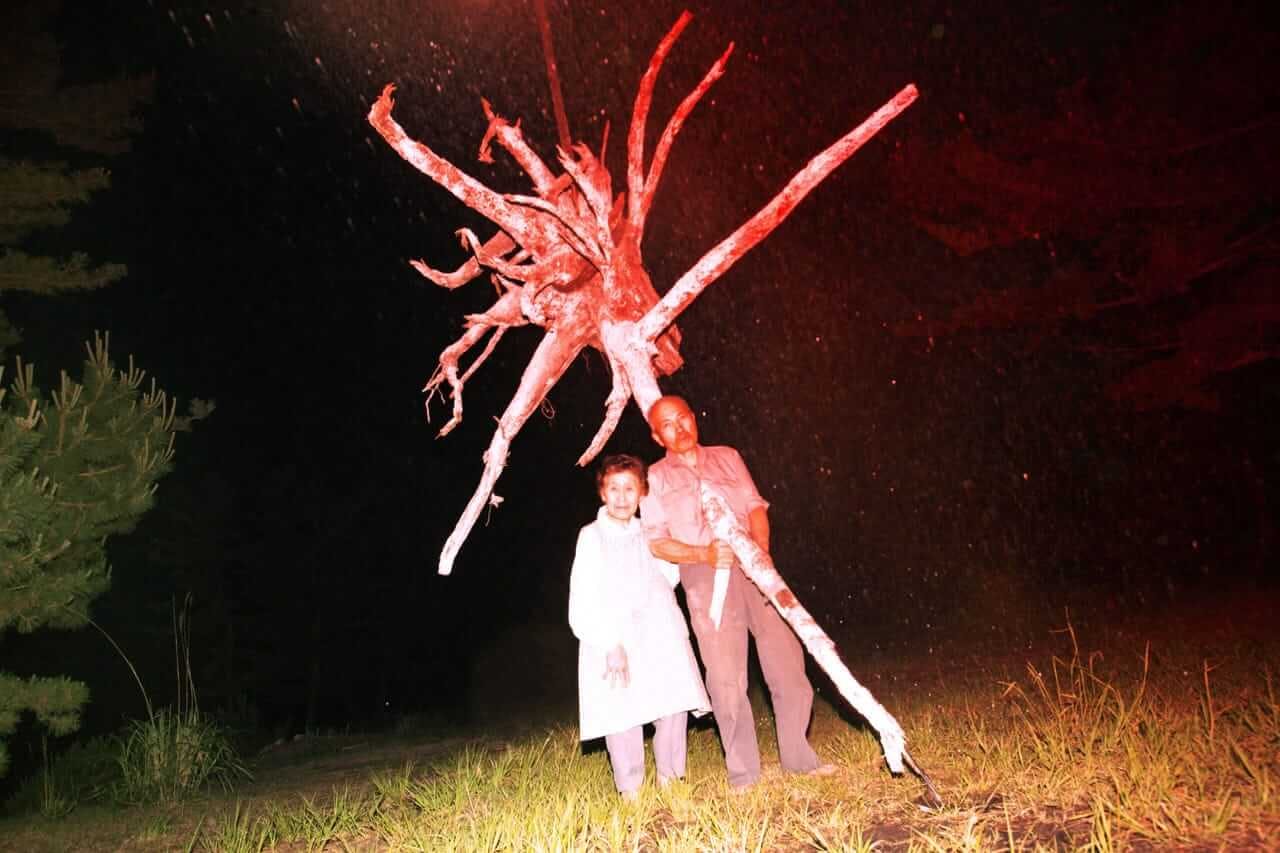I am, inter alia, a tree-grower and cultivator, and owner of a few hectares of ancient natural woodland on the Highland fault line of Scotland. Therefore, when I was asked on which of the exhibition’s available artworks I would like to comment, I did not hesitate to choose Lieko Shiga’s photographic “Portrait of Cultivation,” depicting an old couple from her adopted coastal village, Kitakama, holding a tree from the forest which links their community with the disaster-ridden Fukushima-Daiichi nuclear plant 80 kilometres south.
The tree in this particular artistic portrait of “cultivation” is dead. Its bare, lifeless roots dominate, one pointing like a dagger into the foreground earth. During my childhood in a hill sheep-farming and lead-mining community—amongst the lakes, trees, and mountains—I had always wondered, day-dreaming to and from primary school through this magic land, how it would feel if all trees were inverted, and their elaborate, invisibly-networked root systems reached skyward while their branches were buried underground. Only recently have tree roots begun to be understood as mutual partners with mycorrhizal fungi, which produce huge networks of plant, insect, and fungal life. These stretch as a unitary organism, in some cases over 100 kilometres squared, but are mostly unexplored, hitherto unknown, and so violated by normal human activities without a thought.
The undersea earthquake and tsunami of 11th March 2011, which may have devastated Shiga’s tree at Kitakama, also devastated the society surrounding the Fukushima Daiichi nuclear reactors. I visited Iitate Village in December 2017, part of which is in the obligatory evacuation zone. Covering an area of 230 square kilometres, it is a very large, rural “village” of rolling hills, small rice-growing farms, and charcoal-producing woodlands. I participated in a small seminar involving critical scientists and officially-evacuated (but unofficially resident) rice farmers, working together to find more effective ways of decontaminating their radioactive soil than the official “plan” agreed between the government and Tokyo Electric Power Company (TEPCO), the nuclear owner-operator of Fukushima-Daiichi. This was no plan, only the scraping of a few centimetres of topsoil, bagging it in one-tonne bags, then heaping these, roughly 50 together, in deserted fields. The angry contempt of the scientists and farmers for the government, and even more sharply for TEPCO, was evident in their answer to my question, “what do you plan to do with the bags of radioactive soil?” They replied that there was no further plan, no explanation of what would happen next. As my new “downwinder” friends put it, still residing in their officially-evacuated homes and farms: “All bagged up, and nowhere to go!” The disaster’s contaminated products lay provocatively in the landscape, yet were officially invisible, unspoken, and denied.
This embedded nuclear culture of ignoring—even denigrating and thereby alienating—ordinary civic feelings and responses, appears as a universal of nuclear public relationships. Yet this universal is denied systematically by that same power-imbued and anti-democratic modus vivendi of sovereign power. The old couple in Shiga’s photo, with the dead tree roots stabbing into the buried, radioactive, deadened soil—where life is meant to thrive and reproduce—have been robbed of the very possibility of cultivation. This indicates an ironic aspect of Shiga’s photographic art. Here the portrait is one of only death in (what the philosopher, Giorgio Agamben calls) bare life, akin to the deathly powers of nuclear weaponry, lying inescapably within the same materials of civil nuclear electricity and its ultra-long-term wastes, with no agreed plan for disposal.
The diabolical artistry of what is said to be healthy democratic accountability of the authorities to their citizens is captured in Shiga’s subtle location of apparent life in the form of two elderly humans, carrying a tree whose roots have been rendered incapable of cultivation in the surrounding soil. Instead, the tree is made to look as if it is an agent of death-by-stabbing for the sterile and radioactive soil. What is being cultivated here—and, more importantly, by those unaccountable, invisible, nuclear, sovereign powers—save for denial and the death of interactive, vibrant, dynamic, sovereign life?

